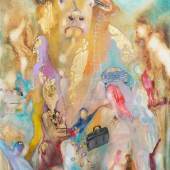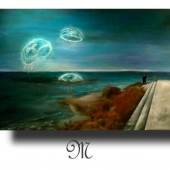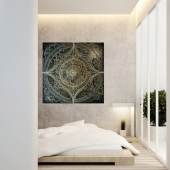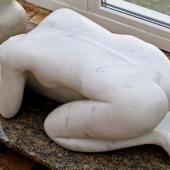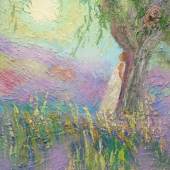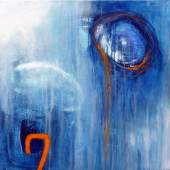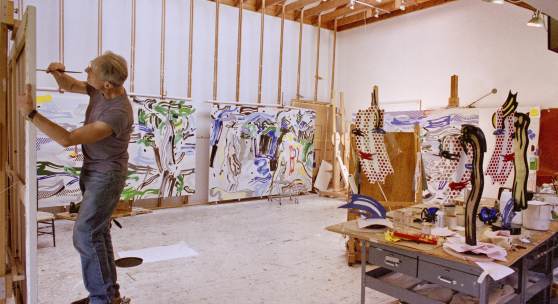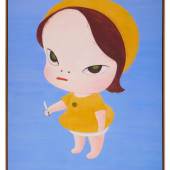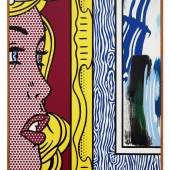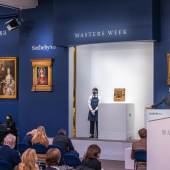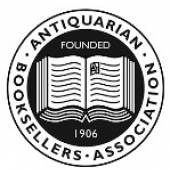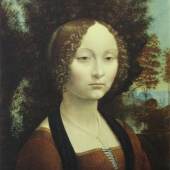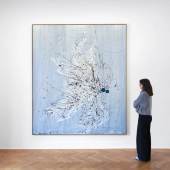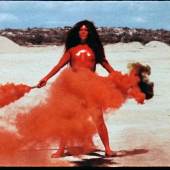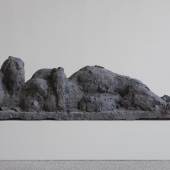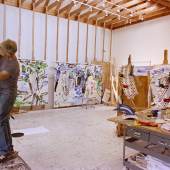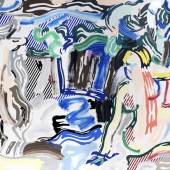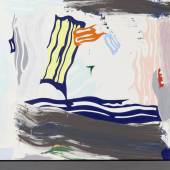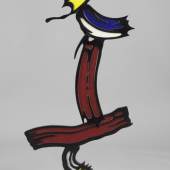Roy Lichtenstein | The Loaded Brush | Salzburg Villa Kast
-
Ausstellung27.07.2019 - 28.09.2019
Juxtaposing both stencilled brushstrokes and freely applied paint on canvas, Roy Lichtenstein produced a number of paintings that drew directly from his predecessors including Pablo Picasso, Paul Cézanne and Willem de Kooning. Dissecting and responding to their methods, he delved into unexplored painterly possibilities while simultaneously distancing each piece from the meaning of its original. While the modernists maintained the notion that the subject of a painting is painting itself, Lichtenstein extended this idea to transform the vehicle of the painting’s expression into its very subject.
Employing a wide repertoire of methods, Lichtenstein translated the gestural strokes of Expressionism into a Pop Art idiom: flattening the brushstroke-form by rendering it in bold, unmodulated colours with heavy black outlines. Denying any presence of the artist’s hand, Lichtenstein’s paintings rejected the subjective emotion of his Expressionist forbears and Neo-expressionist contemporaries, while keenly embracing the concept of ‘bravura’: his brushstrokes embodied both the joy and technical finesse with which he engaged in the process of painting itself – free from personal narrative yet imbued with pleasure and dexterity, executed with a meticulous attention to detail and refined prowess.
Roy Lichtenstein's Brushstroke Realised in Sculptural Form
I did isolate Brushstrokes in 1965 and used cartoon brushstrokes to depict subject matters in the 80s. I also did Brushstroke sculptures in bronze and wood to make them more palpable. … the Brushstroke, it is just an idea to start with, and painting it makes it more concrete, but when you do it in bronze sculpture, it becomes real and has weight and is absurd, contradictory and funny. Roy Lichtenstein, 1991
Roy Lichtenstein’s sculptures of the ’80s developed and parodied the gestural style of Expressionism, as signified by the brushstroke, translating the fluidity of paint into a permanent, metallic medium. Extracted from their canvas support and subverting the medium’s conventional volume and mass, the brushstroke sculptures take the singular, sweeping components identified in his Expressionist-inspired paintings and soar vertically in three-dimensional, dynamic yet flat brushstroke-forms, exploring new concerns with composition, spatiality and experience.
Here emerges something that can equally be observed in many paintings of this phase: a rhythm, which gives them a musical tone. An ascending motion is interrupted, as though a melody were paused on one chord, then continues to flow upwards to a temporary conclusion that suggests further energy. These early 1980s works reflect on the constructivist power of just a few brush-strokes. Even in these simple details there is enormous energy that can soar into monumental works. Siegfried Gohr
We thank Dorothy Lichtenstein and the Lichtenstein family, Jack Cowart and the Roy Lichtenstein Foundation and Barbara Bertozzi Castelli and the Castelli Gallery for their support.
BIOGRAPHY
Roy Lichtenstein (1923-1997) first came to prominence in the early 1960s through large-scale paintings that drew upon the visual repertory of popular culture, in particular comic strips and advertisements. The artist painted by hand, and later using a perforated screen, to mimic the Benday dots used in commercial printing to convey colour gradation and texture, blurring the distinctions between ‘high’ and ‘low’ culture in both form and content. Lichtenstein also ventured beyond comic book subjects, looking back at his art-historical predecessors in paintings that reference Cézanne, Mondrian and Picasso, as well as still-lifes and landscapes.
By the late 1960s, Roy Lichtenstein’s work had become more abstract, exploring the nature and expressive possibilities of the brushstroke itself – this fundamental component of painting came to the fore as a subject in its own right across both paintings and sculptures. Over the following decades, he further probed questions of formalism and abstraction in his Mirrors series (1969–79), evoking the effects of light and shadow on glass, and the Entablatures (1970–76), which investigated similar phenomena using Beaux-Art architectural forms. Lichtenstein also created pioneering painted bronze sculptures that subverted the medium’s conventional volume and mass, functioning instead as flat lines in space. In the 1970s, Lichtenstein expanded his palette beyond red, blue, yellow, black, white and green, as well as combining invented and found images. Having created his first public mural in 1963, Lichtenstein intensified these efforts in the 1980s and 1990s, painting murals and installing monumental public sculptures in cities across the US, as well as in Europe, Israel, Japan and Puerto Rico.
In accordance with the wishes of the artist and his family, the Roy Lichtenstein Foundation was established in 1998 to facilitate access to his work and that of his contemporaries, and to establish a catalogue raisonné of his works, which is an ongoing project.
-
18.11.2021Sotheby’s To Announce Live Bidding Increments in Ether (ETH) Cryptocurrency For Banksy...
-
15.11.2021 - 19.11.2021Sotheby’s Lifts the Curtain onOne of the Most Important Sales Series Ever Staged $1 BILLION...
-
28.01.2022Sotheby’s New York Master Paintings and Sculpture Part ITotals $91 MillionSecond Highest...
-
Founded in 1906 and the oldest organisation of its kind in the world, the Antiquarian Booksellers...
-
Bei Leonardo da Vinci kann wohl guten Gewissens von einem Universal - Genie gesprochen werden. Da...
-
18.05.2024 - 20.07.2025Created in the artist’s studio north of Salzburg, this new series of paintings and ink...
-
21.09.2024 - 25.01.2025Group exhibition Carl Andre Joan Brown Rosemarie Castoro John Chamberlain Judy Chicago Dan Flavin...
-
28.11.2024 - 05.02.2025Marking Joan Snyder’s first solo exhibition with the gallery, Body & Soul is...
-
21.12.2024 - 01.03.2025Diese Ausstellung präsentiert eine Auswahl von Skulpturen Hans Josephsohns (1920–2012), die...
-
11.01.2025 - 22.02.2025The exhibition Sculpture Nails at Thaddaeus Ropac Paris Marais highlights Sylvie Fleury’s...
-
27.07.2019 - 28.09.2019
GALERIE THADDAEUS ROPAC - MARAIS
7 RUE DEBELLEYME, FR-75003 PARISÖFFNUNGSZEITEN
DIENSTAG - SAMSTAG 10 - 19 UHR
